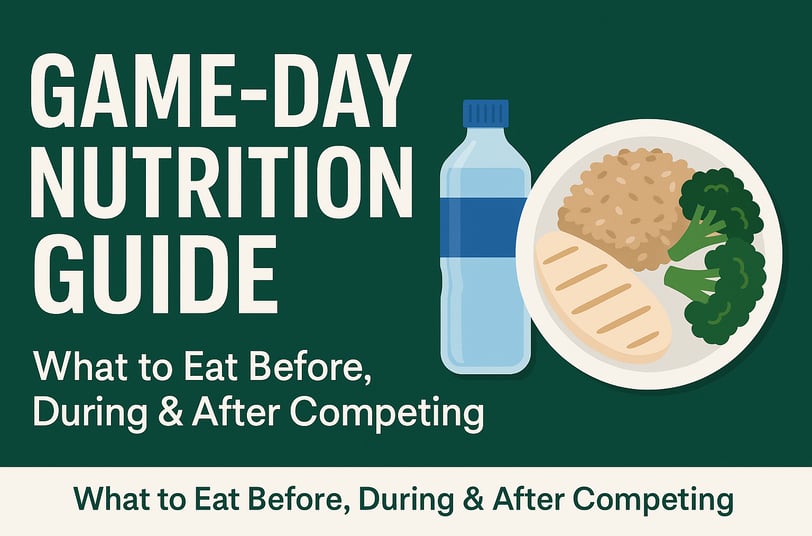Game-Day Nutrition Guide: What to Eat Before, During & After Competing
Want to perform at your best on game day? This complete guide breaks down exactly what to eat and drink before, during, and after a match to fuel energy, improve recovery, and avoid burnout. Includes real product recommendations, hydration tips, and meal timing strategies backed by sports science.
5/29/20252 min read


The One Breathing Habit That’s Wrecking Your Core Stability
Most people think their core is weak because they don’t train it enough. But in reality, a lot of athletes are doing plenty of core work — they’re just breathing in a way that makes all of it way less effective. The habit? Mouth breathing.
When you breathe through your mouth, especially during workouts or sleep, you shift into shallow chest breathing and stop using your diaphragm — the key deep-core muscle responsible for stabilizing your spine through intra-abdominal pressure. Without that pressure, your posture collapses, your ribs flare, and your core can't properly brace. That’s when the low back, hip flexors, and neck start compensating, and everything feels off no matter how many ab workouts you do.
It goes deeper. Mouth breathing also pushes your head forward and tilts your pelvis, wrecking spinal alignment. A study in Clinical Anatomy linked chronic mouth breathing with poor posture and weaker trunk activation. Another study in the Journal of Physical Therapy Science showed that nasal breathers had stronger deep core activation and better postural control. This isn’t some theory — it’s physiology. And the fix isn’t more planks — it’s learning how to breathe right.
That starts with switching to nasal breathing. When you breathe through your nose, you’re forced to engage your diaphragm. That reinforces core control, helps stack your ribcage and pelvis, and restores real bracing mechanics. You generate more power, lift safer, and recover faster. But it takes some retraining.
Product we recommend: Train Nasal Breathing at Night
Dream Mouth Tape
✅ Gently promotes nasal breathing during sleep
✅ Hypoallergenic and comfortable for overnight use
✅ Helps prevent dry mouth and boost next-morning energy
Use this to retrain your nervous system overnight. Most people mouth breathe in their sleep — this tape stops that and helps your body adapt back to the nasal breathing pattern it’s supposed to follow.
During training, nasal breathing isn’t always easy — especially if you’ve got airflow issues. That’s where support tools can help. You don’t need fancy gadgets — you need resistance and clear airways. Breathing against resistance trains your diaphragm and builds endurance. And opening up the nose physically makes it easier to stick to nasal-only breaths during intense movement.
Product we recommend: Strengthen Your Diaphragm
Oxy Ademtrainer
✅ Adds resistance to every nasal inhale
✅ Builds stronger, more controlled breathing mechanics
✅ Great for warm-ups or standalone breathwork
⭐ 4.3 stars
A few minutes of resistance breathing a day can rewire your diaphragm and boost your core engagement naturally — without having to think about it every rep.
Product we recommend: Turbine Nasal Dilator
✅ Instantly improves nasal airflow
✅ Ideal for training, lifting, or cardio sessions
✅ Comfortable and easy to wear
If you’ve got trouble breathing through your nose during intense workouts, this fixes the problem fast. It’s like flipping the switch on clean oxygen without going back to mouth breathing.
Start simple: 5 minutes of nasal-only breathing lying on your back before workouts. Then apply it during warm-ups, walks, and low-intensity work. You’ll feel more grounded, more controlled, and more connected through your core. After a few weeks, that deeper brace will become second nature — and your posture, stability, and lifts will follow.
Final Take:
If your core isn’t doing its job, don’t just train harder — breathe smarter. Mouth breathing disconnects your diaphragm and wrecks your ability to stabilize. Nasal breathing restores it. Lock that in, and everything from your posture to your power output gets better — with less strain and more control.
FITNESS
Nutrition
WellnesS
info@movebetterco.com
© 2025. All rights reserved | Privacy Policy | Terms & Conditions